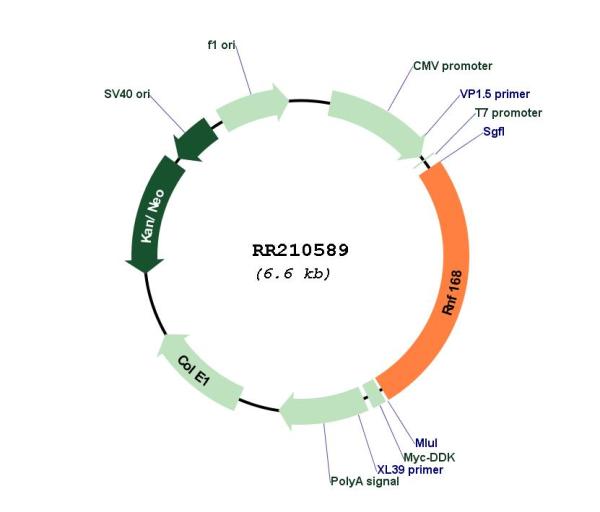Rnf168 (NM_001127597) Rat Tagged ORF Clone
CAT#: RR210589
- TrueORF®
Rnf168 (Myc-DDK-tagged ORF) - Rat ring finger protein 168 (Rnf168), (10 ug)
Lentiviral Particles: DDK w/ Puro mGFP w/ Puro
"NM_001127597" in other vectors (3)
Specifications
| Product Data | |
| Type | Rat Tagged ORF Clone |
| Tag | Myc-DDK |
| Symbol | Rnf168 |
| Synonyms | MGC188789 |
| Vector | pCMV6-Entry |
| E. coli Selection | Kanamycin (25 ug/mL) |
| Mammalian Cell Selection | Neomycin |
| Sequence Data |
>RR210589 representing NM_001127597
Red=Cloning site Blue=ORF Green=Tags(s) TTTTGTAATACGACTCACTATAGGGCGGCCGGGAATTCGTCGACTGGATCCGGTACCGAGGAGATCTGCC GCCGCGATCGCC ATGAAGATGGCTGCACCTAAAAACTCCATCCCTTCCTTAGCGGAATGTCAGTGCGGGATCTGCATGGAAA TCCTCGTAGAGCCTGTTACCCTACCTTGCAACCACACGCTCTGTAACCCATGCTTCCAATCGACTGTTGA AAAGGCCAATTTATGCTGTCCCTTCTGTCGCCGCCGGGTCTCTTCGTGGACTCGGTACCATACCCGAAGA AATTCTCTGGTCAATACAGACCTGTGGGAGATTATTCAAAAGCACTATGCAAAGGAATGCAAGCTTAGAA TCTCTGGACAAGAATCAAAGGAAATCGTTGATGAGTACCAGCCAGTTCGTCTACTCAGTAAACCTGGGGA GTTGAGGCGAGAATATGAAGAGGAGATAAGCAAGGTGGAGGCTGAGCGACAAGCCAGCAAGGAAGAGGAA AACAAAGCCAGTGAGGAGTACATACAGAGACTGCTGGCCGAGGAGGAGGAGGAGGAGAAAAGGCGGACGG AGAGAAGACGAAGTGAGATGGAGGAGCAGCTGAGGGGCGATGAGGAGCTGGCGAGGAGGCTGAGCACCAG CATCAACAGTAACTACGAGAGAAATATCTTGGCATCTCCTTTGAGTTCCAGAAAATCAGATCCCGTCACA AACAAGTCACAGAAGAAAAATACGAACAAACAAAAAAACTTTGGAGATATTCAAAGATACTTGTCACCTA AGTCAAAGCCTGGGACAGCATGGGCATGTAAAACTGAGCATGGAGAAGACATGTGCAAGTCTAAGGAAAC AGACAGTAGTGACACGAAGAGCCCTGTGTTGCAAGACACAGACGTTGAAGAAAGCATGCCAACACATTCT CCTCAGACCTGCCCAGAAACTCAAGGGCAAGGTCCGGAGCCTTTGACAGAGATGCCTGTGCCATGGCTAT GTGCAAGGAATGCTGAACAGTGCCTTGAGGGAAAAGCTGAAGCAGTGTCAACCAATCCTGATGATTCATG TATTGTAAATGATGGTGGACCTAGAGCCATAGTTTCTAACTCTAAGGAAGCTGCAGTTAAGCCTCCTACC AAGATAGAAAACGAAGAGTATTCTGTGTCAGGTGTGACCCAGTTAACTGGGGGCAACGGAGTTCCAACAG AGAGCAGAGTGTACGACTTACTAGTCGGAAAAGAGATTTCCGAAAGAGAAAACCAGGAATCTGTGTTTGA AGAAGTCATGGATCCATGCTTTTCTGCAAAAAGAAGGAAAATATTCATCACATCCTCCTTAGATCAAGAA GAAACAGAAGTGAATTTTACACAAAAACTGATAGATTTGGAACATATGCTTTTCGAGAGACATAAGCAAG AAGAACAGGACAGGTTGTTAGCATTACAACTTCAAAAAGAGGCAGATAAAGAAAAAATGGTGCCAAACCG GCAGAAAGGATCCCCAGATCAGTACCAGCTGCGCACATCTTCACCCCCAGACGGGTTGCTGAATGGACAG AGGAAGAATGTCAAAGATAGGAACTCCCCAAAGCAAACTGCAGATCGTTCAAAATCTCAGAGGAGCAGGA AAGGTGAATACTGGGAGACCTTCGAAAGCACTTGGAAGGGTTCAGTTAATGGAACGAAGATGCCAACTCC TAGGAAAGATAGTTGTAATGTATCTAAACGTGCCTGTCCCCTACAGCACAGAAGTGCACAGAAAAGCATT CTTCAAATGTTTCAGAGG ACGCGTACGCGGCCGCTCGAGCAGAAACTCATCTCAGAAGAGGATCTGGCAGCAAATGATATCCTGGATT ACAAGGATGACGACGATAAGGTTTAA >RR210589 representing NM_001127597
Red=Cloning site Green=Tags(s) MKMAAPKNSIPSLAECQCGICMEILVEPVTLPCNHTLCNPCFQSTVEKANLCCPFCRRRVSSWTRYHTRR NSLVNTDLWEIIQKHYAKECKLRISGQESKEIVDEYQPVRLLSKPGELRREYEEEISKVEAERQASKEEE NKASEEYIQRLLAEEEEEEKRRTERRRSEMEEQLRGDEELARRLSTSINSNYERNILASPLSSRKSDPVT NKSQKKNTNKQKNFGDIQRYLSPKSKPGTAWACKTEHGEDMCKSKETDSSDTKSPVLQDTDVEESMPTHS PQTCPETQGQGPEPLTEMPVPWLCARNAEQCLEGKAEAVSTNPDDSCIVNDGGPRAIVSNSKEAAVKPPT KIENEEYSVSGVTQLTGGNGVPTESRVYDLLVGKEISERENQESVFEEVMDPCFSAKRRKIFITSSLDQE ETEVNFTQKLIDLEHMLFERHKQEEQDRLLALQLQKEADKEKMVPNRQKGSPDQYQLRTSSPPDGLLNGQ RKNVKDRNSPKQTADRSKSQRSRKGEYWETFESTWKGSVNGTKMPTPRKDSCNVSKRACPLQHRSAQKSI LQMFQR TRTRPLEQKLISEEDLAANDILDYKDDDDKV |
| Restriction Sites |
SgfI-MluI
Cloning Scheme for this gene
Plasmid Map

|
| ACCN | NM_001127597 |
| ORF Size | 1698 bp |
| OTI Disclaimer | The molecular sequence of this clone aligns with the gene accession number as a point of reference only. However, individual transcript sequences of the same gene can differ through naturally occurring variations (e.g. polymorphisms), each with its own valid existence. This clone is substantially in agreement with the reference, but a complete review of all prevailing variants is recommended prior to use. More info |
| OTI Annotation | This clone was engineered to express the complete ORF with an expression tag. Expression varies depending on the nature of the gene. |
| Product Components | The ORF clone is ion-exchange column purified and shipped in a 2D barcoded Matrix tube containing 10ug of transfection-ready, dried plasmid DNA (reconstitute with 100 ul of water). |
| Reconstitution | 1. Centrifuge at 5,000xg for 5min. 2. Carefully open the tube and add 100ul of sterile water to dissolve the DNA. 3. Close the tube and incubate for 10 minutes at room temperature. 4. Briefly vortex the tube and then do a quick spin (less than 5000xg) to concentrate the liquid at the bottom. 5. Store the suspended plasmid at -20°C. The DNA is stable for at least one year from date of shipping when stored at -20°C. |
| Reference Data | |
| RefSeq | NM_001127597.2, NP_001121069.2 |
| RefSeq Size | 3311 bp |
| RefSeq ORF | 1701 bp |
| Locus ID | 690043 |
| UniProt ID | B2RYR0 |
| Cytogenetics | 11q22 |
| MW | 64.7 kDa |
| Gene Summary | E3 ubiquitin-protein ligase required for accumulation of repair proteins to sites of DNA damage. Acts with UBE2N/UBC13 to amplify the RNF8-dependent histone ubiquitination. Recruited to sites of DNA damage at double-strand breaks (DSBs) by binding to ubiquitinated histone H2A and H2AX and amplifies the RNF8-dependent H2A ubiquitination, promoting the formation of 'Lys-63'-linked ubiquitin conjugates. This leads to concentrate ubiquitinated histones H2A and H2AX at DNA lesions to the threshold required for recruitment of TP53BP1 and BRCA1. Also recruited at DNA interstrand cross-links (ICLs) sites and promotes accumulation of 'Lys-63'-linked ubiquitination of histones H2A and H2AX, leading to recruitment of FAAP20 and Fanconi anemia (FA) complex, followed by interstrand cross-link repair. H2A ubiquitination also mediates the ATM-dependent transcriptional silencing at regions flanking DSBs in cis, a mechanism to avoid collision between transcription and repair intermediates. Also involved in class switch recombination in immune system, via its role in regulation of DSBs repair. Following DNA damage, promotes the ubiquitination and degradation of JMJD2A/KDM4A in collaboration with RNF8, leading to unmask H4K20me2 mark and promote the recruitment of TP53BP1 at DNA damage sites. Not able to initiate 'Lys-63'-linked ubiquitination in vitro; possibly due to partial occlusion of the UBE2N/UBC13-binding region. Catalyzes monoubiquitination of 'Lys-13' and 'Lys-15' of nucleosomal histone H2A (H2AK13Ub and H2AK15Ub, respectively).[UniProtKB/Swiss-Prot Function] |
Documents
| Product Manuals |
| FAQs |
| SDS |
Resources
Other Versions
| SKU | Description | Size | Price |
|---|---|---|---|
| RN210589 | Rnf168 (untagged ORF) - Rat ring finger protein 168 (Rnf168), (10 ug) |
USD 581.00 |
|
| RR210589L3 | Lenti ORF clone of Rnf168 (Myc-DDK-tagged ORF) - Rat ring finger protein 168 (Rnf168), (10 ug) |
USD 880.00 |
|
| RR210589L4 | Lenti ORF clone of Rnf168 (mGFP-tagged ORF) - Rat ring finger protein 168 (Rnf168), (10 ug) |
USD 880.00 |
{0} Product Review(s)
Be the first one to submit a review






























































































































































































































































 Germany
Germany
 Japan
Japan
 United Kingdom
United Kingdom
 China
China


